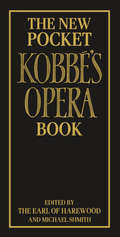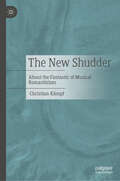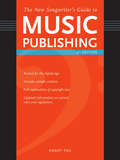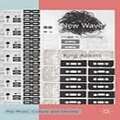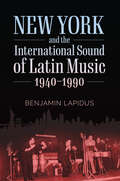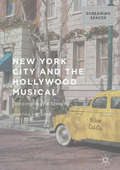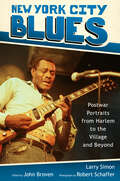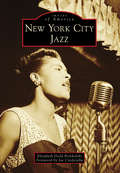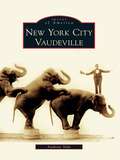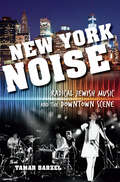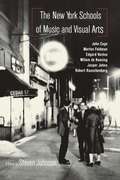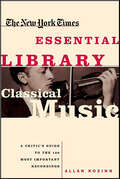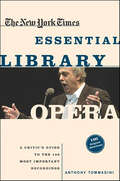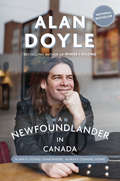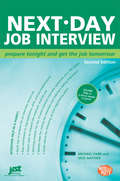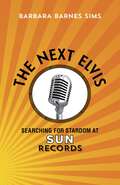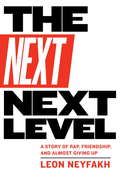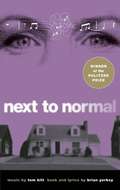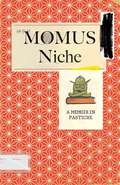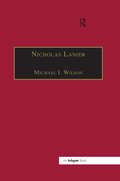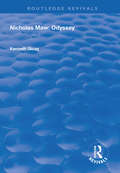- Table View
- List View
The New Pocket Kobbé's Opera Book
by Earl Of HarwoodThe New Pocket Kobbe's Complete Opera Book is the world's leading reference work on opera, and (in the words of Bernard Levin) 'no single-volume operatic guide can possibly compare with it'. Kobbe is the only book which summaries the libretti of the world's opera, describes their music and gives a history of their performance within a single volume. But it is a large and relatively expensive book. The new pocket edition, at a price accessible to the huge new audience for opera, has been redesigned and extended, existing entries have been rewritten, and new operas included. The total number of works covered is now over 200, including important new works like John Adams Nixon in China, Harrison Birtwistle's Gawain and Thomas Ades's Powder Her Face, and a number of half-forgotten works that are now undergoing revival. Unlike the previous edition, it is now simply arranged, alphabetically by composer. Lord Harewood's strongly individual commentaries, together with his unparalleled knowledge of and enthusiasm for opera, make the New Pocket Kobbe a book no opera-goer can afford to be without.
The New Shudder: About the Fantastic of Musical Romanticism
by Christian Kämpf"It is a new shudder, but not an old fear." Jean Paul's sentence contains an aesthetic of the fantastic in nuce. It is based not least on the philosophy of Friedrich Heinrich Jacobi and aims at the essence of Romanticism. In addition to works by Mozart, Beethoven, Schumann and Wagner, the Romantic magic opera by Spohr, Weber and Marschner are placed in the centre of interest against this background, as well as the music-aesthetic discourse accompanying them, which was led by Tieck, Hoffmann and Horn, A. B. Marx, Brendel and Pohl, are analysed. Contrary to the tradition of musicological research, which, if not taboo, at least trivialised the fantastic, Kämpf arrives at a new understanding of musical Romanticism, according to which it does not lose its affiliation with modernity and its impact on the present because of the fantastic, but only gains it.
The New Songwriter's Guide to Music Publishing - 3rd Edition
by Randy PoeProvides insider knowledge and advice that's easy to understand, so songwriters can get the best deals for their songs.
New Wave: Image is Everything (Pop Music, Culture and Identity)
by K. AdkinsNew Wave: Image is Everything traces the evolution of the often neglected pop music genre, new wave. Using artists from Elvis Costello to Cyndi Lauper as illustrations, the book argues that new wave was among the first flowerings of postmodern theory in popular culture.
New Wave
by M. King AdkinsWhile punk often receives more scholarly attention, new wave marks an even more important turning point in music history, one that continues to resonate in popular culture today. New Wave: Image is Everything traces the evolution of this often neglected pop genre by focusing on an eclectic collection of artists from Elvis Costello to Cyndi Lauper, Devo to Duran Duran. In addition, it explores a number of important historical moments, such as MTV's first broadcast, and how these moments helped to shape our world. The book also argues that new wave was among the first flowerings of postmodern theory in popular culture, and in doing so it not only provides a history of new wave, but also helps explain the basic principles of postmodernism by putting them in easy to understand terms.
New York and the International Sound of Latin Music, 1940-1990 (American Made Music Series)
by Benjamin LapidusNew York City has long been a generative nexus for the transnational Latin music scene. Currently, there is no other place in the Americas where such large numbers of people from throughout the Caribbean come together to make music. In this book, Benjamin Lapidus seeks to recognize all of those musicians under one mighty musical sound, especially those who have historically gone unnoticed. Based on archival research, oral histories, interviews, and musicological analysis, Lapidus examines how interethnic collaboration among musicians, composers, dancers, instrument builders, and music teachers in New York City set a standard for the study, creation, performance, and innovation of Latin music. Musicians specializing in Spanish Caribbean music in New York cultivated a sound that was grounded in tradition, including classical, jazz, and Spanish Caribbean folkloric music. For the first time, Lapidus studies this sound in detail and in its context. He offers a fresh understanding of how musicians made and formally transmitted Spanish Caribbean popular music in New York City from 1940 to 1990. Without diminishing the historical facts of segregation and racism the musicians experienced, Lapidus treats music as a unifying force. By giving recognition to those musicians who helped bridge the gap between cultural and musical backgrounds, he recognizes the impact of entire ethnic groups who helped change music in New York. The study of these individual musicians through interviews and musical transcriptions helps to characterize the specific and identifiable New York City Latin music aesthetic that has come to be emulated internationally.
New York City and the Hollywood Musical
by Martha ShearerIn examining the relationship between the spectacular, iconic and vibrant New York of the musical and the off-screen history and geography of the real city--this book explores how the city shaped the genre and equally how the genre shaped representations of the city. Shearer argues that while the musical was for many years a prime vehicle for the idealization of urban density, the transformation New York underwent after World War II constituted a major challenge to its representation. Including analysis of 42nd Street, Swing Time, Cover Girl, On the Town, The Band Wagon, Guys and Dolls, West Side Story and many other classic and little-known musicals--this book is an innovative study of the relationship between cinema and urban space.
New York City Blues: Postwar Portraits from Harlem to the Village and Beyond (American Made Music Series)
by Larry SimonA first-ever book on the subject, New York City Blues: Postwar Portraits from Harlem to the Village and Beyond offers a deep dive into the blues venues and performers in the city from the 1940s through the 1990s. Interviews in this volume bring the reader behind the scenes of the daily and performing lives of working musicians, songwriters, and producers. The interviewers capture their voices — many sadly deceased — and reveal the changes in styles, the connections between performers, and the evolution of New York blues. New York City Blues is an oral history conveyed through the words of the performers themselves and through the photographs of Robert Schaffer, supplemented by the input of Val Wilmer, Paul Harris, and Richard Tapp. The book also features the work of award-winning author and blues scholar John Broven. Along with writing a history of New York blues for the introduction, Broven contributes interviews with Rose Marie McCoy, “Doc” Pomus, Billy Butler, and Billy Bland. Some of the artists interviewed by Larry Simon include Paul Oscher, John Hammond Jr., Rosco Gordon, Larry Dale, Bob Gaddy, “Wild” Jimmy Spruill, and Bobby Robinson. Also featured are over 160 photographs, including those by respected photographers Anton Mikofsky, Wilmer, and Harris, that provide a vivid visual history of the music and the times from Harlem to Greenwich Village and neighboring areas. New York City Blues delivers a strong sense of the major personalities and places such as Harlem’s Apollo Theatre, the history, and an in-depth introduction to the rich variety, sounds, and styles that made up the often-overlooked New York City blues scene.
New York City Jazz
by Joe Cinderella Elizabeth Dodd BrinkofskiNew York City Jazz explores many of the haunts and hideaways that have played host to iconic jazz musicians and singers like Charlie Parker, Miles Davis, John Coltrane, Bill Evans, Billie Holiday, Dizzy Gillespie, and Lester Young. Considered the jazz capital of the world, New York City is known for its flashy venues. The stages of the Latin Quarter, Apollo Theater, Minton's Playhouse, Onyx, Stork Club, Downbeat Club, Birdland, Roseland, and Copacabana came to life with the sounds of pianos, drums, horns, and gypsy guitars. This collection of images presents why Fifty-second Street was nicknamed "Swing Street" and how musicians made timeless names for themselves in the Empire City.
New York City Vaudeville
by Anthony SlideNew York City Vaudeville provides a unique pictorial record of America's preeminent entertainment medium in the late 1800s through the early 1930s. New York's Palace Theatreserved as the flagship for vaudeville, on which stage everyvaudevillian aspired to perform. New York City Vaudevillefeatures photographs of some of the greatest names fromthe Palace Theatre, including Jack Benny, George Burnsand Gracie Allen, Anna Held, the Marx Brothers, and Eva Tanguay, as well as legendary African American performers such as Bill Robinson, Ethel Waters, and Bert Williams. Through the photographs and the capsule biographies, the reader is transported back to a time when vaudeville was the people's entertainment, with a new bill of fare each week and an ever-changing number of performers with ever-changing styles of presentation.
New York Noise: Radical Jewish Music and the Downtown Scene (Ethnomusicology Multimedia)
by Tamar BarzelAn up-close view of the 1990s music scene that brought us neo-klezmer bands, Tzadik Records, and a new vision of Jewish identity.Coined in 1992 by composer/saxophonist John Zorn, “Radical Jewish Culture,” or RJC, became the banner under which many artists in Zorn’s circle performed, produced, and circulated their music. New York’s downtown music scene, part of the once-grungy Lower East Side, has long been the site of cultural innovation, and it is within this environment that Zorn and his circle sought to combine, as a form of social and cultural critique, the unconventional, uncategorizable nature of downtown music with sounds that were recognizably Jewish.Out of this movement arose bands, like Hasidic New Wave and Hanukkah Bush, whose eclectic styles encompassed neo-klezmer, hardcore and acid rock, neo-Yiddish cabaret, free verse, free jazz, and electronica. Though relatively fleeting in rock history, the “RJC moment” produced a six-year burst of conversations, writing, and music—including festivals, international concerts, and nearly two hundred new recordings. During a decade of research, Tamar Barzel became a frequent visitor at clubs, post-club hangouts, musicians’ dining rooms, coffee shops, and archives. Her book describes the way RJC forged a new vision of Jewish identity in the contemporary world, one that sought to restore the bond between past and present, to interrogate the limits of racial and gender categories, and to display the tensions between secularism and observance, traditional values and contemporary concerns.Includes links to audiovisual content
New York Rock: From the Rise of The Velvet Underground to the Fall of CBGB
by Steven BlushSteven Blush's New York Rock presents the definitive history of a key period in rock ‘n’ roll, from new wave to no wave, punk to punk revival, from the bestselling author of American Hardcore. As a city that represents endless possibilities, New York has been the setting for the dawning of new movements, styles, and genres. In the 20th century, the birth of Rock represented a connection between art forms and the city’s socioeconomic, racial, and sexual variants. New York Rock breaks down the rock scene’s half-century connection to New York and analyzes its distinct subculture through the prism of influences, crosscurrents and psychoactive distractions. Over 1,500 musicians, clubs, and labels, from Madonna to the Ramones, held roles in the making of New York Rock, and it’s their contributions that created this iconic art form. A compilation of firsthand narratives about each genre of rock, from Punk New Wave and Glitter Rock to New York Hardcore and Indie rock, New York Rock is the ultimate illustrated account of Rock’s role in New York City.
The New York Schools of Music and the Visual Arts
by Willem De Kooning John Cage Morton Feldman Edgard Varèse Jasper Johns Robert RauschenbergMusicians and artists have always shared mutual interests and exchanged theories of art and creativity. This exchange climaxed just after World War II, when a group of New York-based musicians, including John Cage, Morton Feldman, Earle Brown, and David Tudor, formed friendships with a group of painters. The latter group, now known collectively as either the New York School or the Abstract Expressionists, included Jackson Pollock, Willem deKooning, Robert Motherwell, Mark Rothko, Barnett Newman, Clyfford Still, Franz Kline, Phillip Guston, and William Baziotes. The group also included a younger generation of artists-particularly Robert Rauschenberg and Jasper Johns-that stood somewhat apart from the Abstract Expressionists. This group of painters created what is arguably the first significant American movement in the visual arts. Inspired by the artists, the New York School composers accomplished a similar feat. By the beginning of the 1960s, the New York Schools of art and music had assumed a position of leadership in the world of art. For anyone interested in the development of 20th century art, music, and culture, The New York Schools of Music and Art will make for illuminating reading.
The New York Times Essential Library: Classical Music
by Allan KozinnA dazzling appraisal of the definitive classical music performances available todayFor classical music lovers, there is nothing more beguiling and exciting than the range of technique and emotion that can capture or transform the great works in the hands of a conductor and musicians. But with hundreds of recordings released every year, discovering the jewels is a challenge, for newcomers as well as for connoisseurs.New York Times classical music critic Allan Kozinn offers the ultimate collector's guide, packed with a rich history of the composers and performers who stir our souls. From Bach's eloquent Goldberg Variations performed by master pianist Glenn Gould at the beginning and end of his career in startlingly different interpretations, to a lyrical performance of Rimsky-Korsakov's Scheherezade conducted by Kiril Kondrashin shortly after his defection from the Soviet Union, Kozinn places each work in the greater context of musical development and stretches the listener's understanding of each pivotal composition. These original essays on the one hundred greatest recorded classical works provide both practical guidance for building a library and deep insight into the transcendent power of music itself.
The New York Times Essential Library: Opera (The New York Times Essential Library)
by Anthony TommasiniAn insightful, provocative selection of the best opera performances, chosen by The New York Times's chief classical music critic in one hundred original essaysOpera intertwines the drama of the theater with the powerful emotionality of music. In this magical and illuminating guide to the best opera recordings, Anthony Tommasini delves into the ways story and music interweave to create the subtle but telling moments that move us. Tommasini brings to life the rich history of opera performance and the singers and conductors who, over the past century, have come to own the music. He chooses masterworks, such as Arturo Toscanini's La Boheme, captured for posterity fifty years after he conducted the opera's 1896 premiere for Puccini, and Leontyne Price's Leonora in Il Trovatore, an encapsulation of the ideal Verdi soprano. For aficionados and newcomers alike, Tommasini is the perfect guide to the passions and playfulness of the opera.
A Newfoundlander in Canada: Always Going Somewhere, Always Coming Home
by Alan DoyleFollowing the fantastic success of his bestselling memoir, Where I Belong, Great Big Sea front man Alan Doyle returns with a hilarious, heartwarming account of leaving Newfoundland and discovering Canada for the first time.Armed with the same personable, candid style found in his first book, Alan Doyle turns his perspective outward from Petty Harbour toward mainland Canada, reflecting on what it was like to venture away from the comforts of home and the familiarity of the island. Often in a van, sometimes in a bus, occasionally in a car with broken wipers "using Bob's belt and a rope found by Paddy's Pond" to pull them back and forth, Alan and his bandmates charted new territory, and he constantly measured what he saw of the vast country against what his forefathers once called the Daemon Canada. In a period punctuated by triumphant leaps forward for the band, deflating steps backward and everything in between—opening for Barney the Dinosaur at an outdoor music festival, being propositioned at a gas station mail-order bride service in Alberta, drinking moonshine with an elderly church-goer on a Sunday morning in PEI—Alan's few established notions about Canada were often debunked and his own identity as a Newfoundlander was constantly challenged. Touring the country, he also discovered how others view Newfoundlanders and how skewed these images can sometimes be. Asked to play in front of the Queen at a massive Canada Day festival on Parliament Hill, the concert organizers assured Alan and his bandmates that the best way to showcase Newfoundland culture was for them to be towed onto stage in a dory and introduced not as Newfoundlanders but as "Newfies." The boys were not amused. Heartfelt, funny and always insightful, these stories tap into the complexities of community and Canadianness, forming the portrait of a young man from a tiny fishing village trying to define and hold on to his sense of home while navigating a vast and diverse and wonder-filled country.
Newly Composed Folk Music of Yugoslavia (Current Research in Ethnomusicology: Outstanding Dissertations #Vol. 1)
by Ljerka V. RasmussenFirst published in 2003. Routledge is an imprint of Taylor & Francis, an informa company.
Next-Day Job Interview
by Dick Gaither Michael FarrDistills JIST's revolutionary and proven interview advice into seven quick chapters covering self-assessment, company research, key questions, a system for answering any question that might come up, unusual situations, following up after the interview, salary negotiation, and more.
The Next Elvis: Searching for Stardom at Sun Records
by Barbara Barnes SimsAn American institution, Sun Records has a history with many chapters -- its Memphis origins with visionary Sam Phillips, the breakthrough recordings of Elvis Presley, and the studio's immense influence on the sound of popular music. But behind the company's chart toppers and legendary musicians there exists another story, told by Barbara Barnes Sims. In the male-dominated workforce of the 1950s, 24-year-old Sims found herself thriving in the demanding roles of publicist and sales promotion coordinator at Sun Records. Sims's job placed her in the studio with Johnny Cash, Roy Orbison, Jerry Lee Lewis, Charlie Rich, Carl Perkins, and other Sun entertainers, as well as the unforgettable Phillips, whose work made the music that defined an era.The Next Elvis: Searching for Stardom at Sun Records chronicles Sims's career at the studio, a pivotal time at this recording mecca, as she darted from disc jockeys to distributors. Sims not only entertains with personal stories of big personalities, but also brings humor to the challenges of a young woman working in a fast and tough industry.Her disarming narrative ranges from descriptions of a disgraced Jerry Lee Lewis to the remarkable impact and tragic fall of DJ Daddy-O Dewey to the frenzied Memphis homecoming of Elvis after his military service. Collectively, these vignettes offer a rare and intimate look at the people, the city, and the studio that permanently shifted the trajectory of rock 'n' roll.
The Next Next Level
by Leon NeyfakhIn the tradition of Carl Wilson's Let's Talk About Love, an unforgettable account of fame, fandom, and the problem of making art in the twenty-first century In his multi-hyphenate ambitions, the musician who calls himself Juiceboxxx couldn't be more modern--you might call him a punk rock-rapper-DJ-record executive-energy drink-magnate. Journalist Leon Neyfakh has been something more than a fan of Juiceboxxx's since he was a teenager, when he booked a show for the artist in a church basement in his hometown of Oak Park, Illinois. Juiceboxxx went on to the tireless, lonely, possibly hopeless pursuit of success on his own terms--no club was too dank, no futon too grubby, if it helped him get to the next, next level. And, for years, Neyfakh remained haunted from afar: was art really worth all the sacrifices? If it was, how did you know you'd made it? And what was the difference, anyway, between a person like Juiceboxxx--who devoted his life to being an artist--and a person like Neyfakh, who elected instead to pursue a stable career and a comfortable, middle-class existence? Much more than a brilliant portrait of a charismatic musician always on the verge of something big, The Next Next Level is a wholly contemporary story of art, obsession, fame, ambition, and friendship--as well as viral videos, rap-rock, and the particulars of life on the margins of culture.From the Trade Paperback edition.
Next to Normal
by Tom Kitt Brian YorkeyWinner of the 2010 Pulitzer Prize for Drama"Rock is alive and rolling like thunder in Next to Normal. It's the best musical of the season by a mile...an emotional powerhouse with a fire in its soul and a wicked wit that burns just as fiercely."-Rolling Stone"No show on Broadway right now makes as a direct grab for the heart-or wrings it as thoroughly-as Next to Normal does. . . . [It] focuses squarely on the pain that cripples the members of a suburban family, and never for a minute does it let you escape the anguish at the core of their lives. Next to Normal does not, in other words, qualify as your standard feel-good musical. Instead this portrait of a manic-depressive mother and the people she loves and damages is something much more: a feel-everything musical, which asks you, with operatic force, to discover the liberation in knowing where it hurts."-Ben Brantley, The New York TimesWinner of three 2009 Tony Awards, including Best Original Score (Music and/or Lyrics) Written for the Theatre, Next to Normal is also available in an original cast recording. It was named Best Musical of the Season by Rolling Stone, The Washington Post, Los Angeles Times, and The New York Times.Brian Yorkey received the 2009 Tony Award for Best Original Score for his work on Next to Normal and was also nominated for Best Book of a Musical. His other credits include Making Tracks and Time After Time.Tom Kitt received two 2009 Tony Awards for Best Original Score and Best Orchestrations for Next to Normal. He also composed the music for High Fidelity and From Up Here. His string arrangements appear on the new Green Day album 21st Century Breakdown, and he is the leader of the Tom Kitt Band.
The Nibelungen Tradition: An Encyclopedia (Reference Library Of The Humanities)
by Francis G. Gentry Winder McConnell Ulrich Muller Werner WunderlichWithin the English-speaking world, no work of the German High Middle Ages is better known than the Nibelungenlied, which has stirred the imagination of artists and readers far beyond its land of origin. Its international influence extends from literature to music, art, film, politics and propaganda, psychology, archeology, and military history.Now
Niche: A Memoir in Pastiche
by Momus"Diarist, novelist, satirist, lyricist beyond peer."* In Niche: A Memoir in Pastiche, Nick Currie, a.k.a. Momus, presents the story of his life, career, and conquests on the margins of multiple music and art scenes.Momus—named for the ancient Greek god of mockery, and described by The Guardian as “the David Bowie of the art-pop underground”—has recorded over thirty albums for labels like 4AD and Creation, published half a dozen works of speculative fiction, and written articles for The New York Times, Wired, ArtForum, Frieze, and The Wire. An unknown band called Pulp once asked him to produce their next album. (He said no.) An unknown band called Of Montreal once invited him to go on tour with them. (He said no.) He’s collaborated with fans Vampire Weekend and with the Magnetic Fields’ Stephin Merrit. He’s had an impression of his penis preserved by the notorious Cynthia Plaster Caster. Maybe you’ve heard of him. Probably you haven’t. This is his story. Or, rather, stories.Rather than one avuncular tell-all relayed in his own voice, Momus has structured the narrative of his life as a typically atypical mockery of the rock-bio oral history. Instead of using living witnesses, Momus assumes the voices of 217 dead authors and artists and forces them to speak for and about him. From these dramatic monologues—sometimes unreliable, often comical—there gradually emerges a picture of one eccentric star’s life across three continents and in his own, remarkable, niche."Herein is spun the tale of the immortally fabulous life and glittering times of our dodgy Anthropocene’s greatest still-living songwriter, as related by a chorus of eerie, mocking, sometimes supportive, often judgmental post-mortem Raudive voices in a séance spanning centuries of ectoplasmic ‘I told you so.’ Here is why Momus may one day be canonized the first saint of a religion yet to be dreamed . . . Read, be enlightened, and pretend you always knew." *—Grant Morrison, comic book writer and superfan
Nicholas Lanier: Master of the King's Musick
by MichaelI. WilsonNicholas Lanier (1588-1666) was not only the first person to hold the office of Master of the Music to King Charles I, he was also a practising painter, a friend of Rubens, Van Dyck and many other artists of his time, and one of the very first great art collectors and connoisseurs. He is especially remembered for the part he played in acquiring, on behalf of Charles I, the famous collection of paintings belonging to the Gonzaga family of Mantua. Many of these paintings still form an important part of the Royal Collection today. In this book the different strands of Lanier's colourful life are for the first time drawn together and presented in a single compelling narrative.
Nicholas Maw: Odyssey (Routledge Revivals)
by Kenneth GloagThis book was originally published in 2008. Nicholas Maw's Odyssey is a landmark in contemporary music; at approximately 90 minutes it is one of the longest continuous examples of music written for full-orchestra and received a first, truncated, performance at the 1987 BBC Proms. It took Maw many years to complete and was later recorded to great acclaim by Sir Simon Rattle and the City of Birmingham Symphony Orchestra. In his examination of Odyssey, Kenneth Gloag provides a detailed discussion of Maw's musical identity and reputation as a contemporary composer in relation to romanticism, modernism and postmodernism, taking into consideration his break-through work Scenes and Arias (1962) and the subsequent progression to Odyssey. The book investigates issues of time and narrative crucial to the generation of the work's remarkable length, and considers the relationship between the sectionalization of the score and prevailing sense of unity in the music. Situating Odyssey in larger historical and critical frameworks, Gloag evaluates the initial reception of the work and reflects on Maw's music composed after Odyssey.
